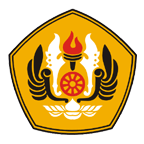Acute Oral Toxicity of Cincalok Oil in Wistar Rats
Abstrak
Cincalok is a West Kalimantan traditional fermented food that has an opportunity to be developed into supplement products as a source of omega 3 and astaxanthin. This study was designed to observe the acute toxicity of Cincalok oil in female rats for its safety profile using AOT 425 program. Cincalok oil for the acute (2000 and 5000 mg/kg) toxicity studies was administered orally according to the OECD guidelines 425. The rat’s body and organs weight were observed then signs of toxicity were assessed. LD50 was being determined at the end of the study. The result showed that a single dose of Cincalok oil at 2000 or 5000 mg/kg had no lethal effect, behavioral change, a significant change in rat’s bodyweights, or any lesion on the rat’s organs. The LD50 of Cincalok oil for oral administration was higher than 5000 mg/kg and categorized as practically non-toxic.
Keywords: Acute Toxicity, Cincalok Oil, LD50.
Teks Lengkap:
PDFReferensi
R. Nofiani and A. Puji. (2018).Physicochemical and Microbiological Profiles of Commercial Cincalok from West Kalimantan. JPHPI. 21, 243–249.
R. Khairina, Y. Fitrial, H. Satrio, and N. Rahmi. (2016). Physical, Chemical, and Microbiological Properties of ‘Ronto’ a Traditional Fermented Shrimp from South Borneo, Indonesia. Aquat. Procedia. 7, 214–220.
W. Syarif, R. Holinesti, A. Faridah, and L. Fridayati. (2017). Analisis Kualitas Sala Udang Rebon. J. Teknol. Pertan. Andalas. 21, 45–51.
S. Chintong, W. Phatvej, U. Rerk-Am, Y. Waiprib, and W. Klaypradit. (2019). In vitro antioxidant, antityrosinase, and cytotoxic activities of astaxanthin from shrimp waste,” Antioxidants. 8, 1–11.
J. Ngginak, H. Semangun, J. C. Mangimbulude, and F. S. Rondonuwu. (2013). Komponen Senyawa Aktif pada Udang Serta Aplikasinya dalam Pangan. J. Sains Med. 5, 128–145.
N. Anzini, I. Kusharyanti, and S. N. Nurbaeti. (2014). Uji Toksisitas Akut Fraksi Etil Asetat Batang dan Daun Pacar Air (Impatiens balsamina Linn) terhadap Tikus Putih Betina Galur Sprague Dawley. J. Trop. Pharm. Chem. 2, 235–247.
E. Nurqolbiah, I. Kusharyanti, and S. N. Nurbaeti. 2014. Uji Toksisitas Fraksi Air Impatiens balsamina Pada Tikus Betina Galur Sprague Dawley. Pharm. Sci. Res. 1, 16–29.
K. Rita, C. Muhammad Nur, U. Tyas, and R. Sri. (2016). Karakteristik Fisikawi, Kimiawi, dan Mikrobiologis Ronto Selama Penyimpanan. JPHPI. 19, 348–355.
A. Aydin, G. Aktay, and E. Yesilada. (2016). A guidance manual for the toxicity assessment of traditional herbal medicines. Nat. Prod. Commun.11, 1763–1773.
Tumisem and E. Puspawiningtiyas. (2011). Kadar Logam dan Cara Mudah Mengenali Udang yang Terakumulasi Logam: Studi Kasus tentang Udang di Sungai Donan Cilacap, Jawa Tengah. J. Mns. dan Lingkung. 18, 114–126.
U. Saleem, S. Amin, B. Ahmad, H. Azeem, F. Anwar, and S. Mary. (2017). “Acute oral toxicity evaluation of aqueous ethanolic extract of Saccharum munja Roxb. roots in albino mice as per OECD 425 TG. Toxicol. Reports. 4, 580–585.
OECD/OECDE. (2008). “Guidelines for the Testing of Chemicals: Acute Oral Toxicity – Up-and-Down-Procedure (UDP). 1-27.
S. Sindhu and P. M. Sherief. (2011). Extraction , Characterization , Antioxidant and Anti-Inflammatory Properties of Carotenoids from the Shell Waste of Arabian Red Shrimp Aristeus alcocki , Ramadan 1938. Open Conf. Proc. J. 2, 95–103.
P. Panicha, N. Supatra, and P. Itthayakorn. (2012). Antimicrobial Activities of Vegetable Oil-Extracted Astaxanthin From Microalgae Haematococcus pluvialis. 1st Mae Fah Luang Univ. Int. Conf. 1–8.
T. Sutrisno, E. Asni, M. Zulkifli, and Ismawati. (2014). Histopatologi aorta torasika tikus putih (Rattus norvegicus strain wistar) Jantan setelah pemberian diet aterogenik selama 12 minggu. Jom FK. 2, 1–14.
T. E. Hamm, A. King-Herbert, and M. A. Vasbinder. (2006). “Chapter 27 – Toxicology,” in The Laboratory Rat. 803–816.
A. B. Sutjiatmo, E. Y. Sukandar, Candra, and S. N. Vikasari. (2015). “Uji toksisitas akut ekstrak air herba pecut kuda (Stachytarpheta jamaicensis L. Vahl) pada mencit Swiss Webster. J. Ilm. Farm. 3, 37–42.
G. N. Teke and V. Kuete. (2014). Acute and Subacute Toxicities of African Medicinal Plants. Elsevier Inc. 63-98.
T. Katsumata, T. Ishibashi, and D. Kyle. (2014). A sub-chronic toxicity evaluation of a natural astaxanthin-rich carotenoid extract of Paracoccus carotinifaciens in rats. Toxicol. Reports. 1, 582–588.
T. Niu et al. 2020. Safety assessment of astaxanthin from Haematococcus pluvialis: Acute toxicity, genotoxicity, distribution and repeat-dose toxicity studies in gestation mice. Regul. Toxicol. Pharmacol. 115.
DOI: https://doi.org/10.24198/ijpst.v8i2.26343
Refbacks
- Saat ini tidak ada refbacks.
| Switch to English Back to Top |
| View My Stats Penerbit Universitas Padjadjaran
Jurnal ini terindeks di :Creative Commons Attribution :
Based on a work at http://jurnal.unpad.ac.id/ijpst/ |
 Indonesian Journal of Pharmaceutical Science and Technology
Indonesian Journal of Pharmaceutical Science and Technology




